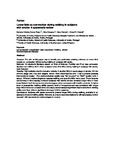Lower limb co-contraction during walking in subjects with stroke: A systematic review
| dc.contributor.author | Rosa, MCN | |
| dc.contributor.author | Marques, A | |
| dc.contributor.author | Demain, Sara | |
| dc.contributor.author | Metcalf, CD | |
| dc.date.accessioned | 2019-06-06T16:20:31Z | |
| dc.date.available | 2019-06-06T16:20:31Z | |
| dc.date.issued | 2014-02 | |
| dc.identifier.issn | 1050-6411 | |
| dc.identifier.issn | 1873-5711 | |
| dc.identifier.uri | http://hdl.handle.net/10026.1/14266 | |
| dc.description.abstract |
PURPOSE: The aim of this paper was to identify and synthesise existing evidence on lower limb muscle co-contraction (MCo) during walking in subjects with stroke. METHODS: An electronic literature search on Web of Science, PubMed and B-on was conducted. Studies from 1999 to 2012 which analysed lower limb MCo during walking in subjects with stroke, were included. RESULTS: Eight articles met the inclusion criteria: 3 studied MCo in acute stage of stroke, 3 in the chronic stage and 2 at both stages. Seven were observational and 1 had a pretest-posttest interventional design. The methodological quality was "fair to good" to "high" quality (only 1 study). Different methodologies to assess walking and quantify MCo were used. There is some controversy in MCo results, however subjects with stroke tended towards longer MCo in both lower limbs in both the acute and chronic stages, when compared with healthy controls. A higher level of post-stroke walking ability (speed; level of independence) was correlated with longer thigh MCo in the non-affected limb. One study demonstrated significant improvements in walking ability over time without significant changes in MCo patterns. CONCLUSIONS: Subjects with stroke commonly present longer MCo during walking, probably in an attempt to improve walking ability. However, to ensure recommendations for clinical practice, further research with standardized methodologies is needed. | |
| dc.format.extent | 1-10 | |
| dc.format.medium | Print-Electronic | |
| dc.language | en | |
| dc.language.iso | eng | |
| dc.publisher | Elsevier BV | |
| dc.subject | Cerebrovascular disease | |
| dc.subject | Co-contraction | |
| dc.subject | Coactivation | |
| dc.subject | Gait | |
| dc.subject | Locomotion | |
| dc.subject | Stroke | |
| dc.subject | Walking | |
| dc.subject | Gait | |
| dc.subject | Humans | |
| dc.subject | Lower Extremity | |
| dc.subject | Muscle Contraction | |
| dc.subject | Muscle, Skeletal | |
| dc.subject | Stroke | |
| dc.subject | Walking | |
| dc.title | Lower limb co-contraction during walking in subjects with stroke: A systematic review | |
| dc.type | journal-article | |
| dc.type | Journal Article | |
| dc.type | Research Support, Non-U.S. Gov't | |
| dc.type | Review | |
| dc.type | Systematic Review | |
| plymouth.author-url | https://www.ncbi.nlm.nih.gov/pubmed/24246405 | |
| plymouth.issue | 1 | |
| plymouth.volume | 24 | |
| plymouth.publication-status | Published | |
| plymouth.journal | Journal of Electromyography and Kinesiology | |
| dc.identifier.doi | 10.1016/j.jelekin.2013.10.016 | |
| plymouth.organisational-group | /Plymouth | |
| plymouth.organisational-group | /Plymouth/Faculty of Health | |
| plymouth.organisational-group | /Plymouth/Users by role | |
| dc.publisher.place | England | |
| dcterms.dateAccepted | 2013-10-26 | |
| dc.identifier.eissn | 1873-5711 | |
| dc.rights.embargoperiod | Not known | |
| rioxxterms.versionofrecord | 10.1016/j.jelekin.2013.10.016 | |
| rioxxterms.licenseref.uri | http://www.rioxx.net/licenses/all-rights-reserved | |
| rioxxterms.licenseref.startdate | 2014-02 | |
| rioxxterms.type | Journal Article/Review |


